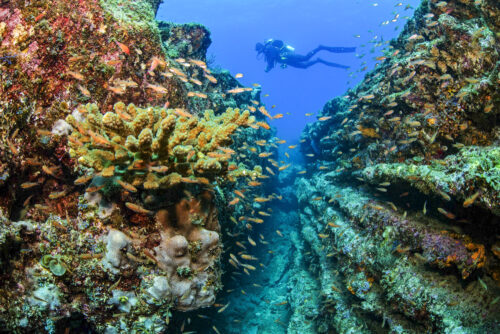
The Untapped Power of Diving: Mapping Mexico’s Underwater Wealth
How Atlas Aquatica is Mapping the True Value of Diving in Mexico and Beyond—Uncovering Its Potential to Transform Coastal Economies, Ecosystems, and Marine Protection Worldwide

Great ideas often strike when we least expect them. For scientist, conservationist, photographer, National Geographic Explorer, and avid diver Octavio Aburto, his lightbulb moment came in the bathtub.
It was 2018. As he reflected on more than 30 years of diving around the world—especially throughout his home country of Mexico—something clicked. He realized he had explored countless sites, yet had never seen a single map of them. Not for Mexico. Not for the world.
And then came the bigger question:
“If we don’t even know where all the dive sites are, how can we know the true value of the entire dive industry?”
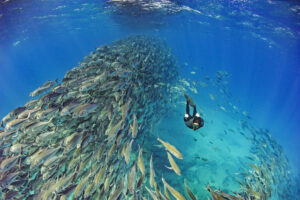
That question sparked the beginning of Atlas Aquatica. The initiative, which combines science, community engagement, diving, and data, is helping coastal communities in Mexico protect marine resources and build regenerative local economies.
Charting the Uncharted: A New Narrative
Octavio secured a grant and assembled a team of young scientists to begin charting the unmapped. They scoured the internet for diving locations and reached out to over 260 dive shops across Mexico to create the most accurate map possible. Following up with economic surveys—asking about shop operations, pricing, and clients—the team began to understand the real value behind the data.
The results surprised even Octavio.
Their surveys revealed that Mexico’s diving industry generated $725 million annually—$25 million more than the country’s entire fishing industry, both artisanal and industrial combined.
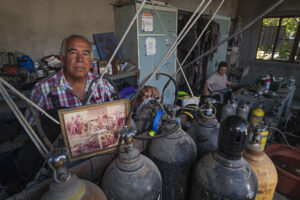
From a quiet moment in a bathtub to a groundbreaking insight, Octavio’s epiphany not only reshaped the narrative around Mexico’s ocean economy—it also raised broader global questions about the diving sector’s potential to fuel regenerative coastal economies and drive effective marine conservation.
A Young Industry, an Untapped Force
News of Octavio’s publication began to spread. While some studies had explored the economic value of specific species—like sharks and rays in The Bahamas—there was still no global map or data capturing the true worth of dive sites worldwide.
With the support of National Geographic Pristine Seas, Octavio’s team set out to change that. They scoured the web for dive shops and businesses across the globe, while calculating the annual global economic value of the diving industry to marine tourism.
“These studies started a new narrative,” Octavio explains. “Everyone started seeing, ‘Wow, this is a powerful economic sector—but it’s really not participating in ocean conservation.’ And we began asking ourselves: Why not?”
What Octavio’s team discovered was that the diving sector—still relatively young, having only gone mainstream in the 1950s and 60s following Jacques Cousteau’s groundbreaking documentaries—remained largely unorganized.
Unlike older, established industries like fishing, diving lacked cooperatives, federations, or unions that could engage in policy, influence marine protection, or amplify their political voice.
“If my country is willing to envision a future where extractive and non-extractive activities are balanced,” Octavio shares, “—if it recognizes that places like La Paz or Cozumel thrive on an economy not based on taking from the ocean, but on bringing people to dive reefs and see whale sharks, generating 80 to 90 percent of the local economy—then we change the paradigm.”
Organizing for the Ocean
Octavio and Atlas Aquatica are working on just that: shifting the paradigm. Their mission is to organize, recognize, and modernize the diving sector—creating a unified voice that can influence policy, secure protections, and support coastal livelihoods.
Today, Atlas Aquatica is part of the United Nations Decade of Ocean Science for Sustainable Development. At the heart of their work is a powerful idea: diving isn’t just exploration—it’s conservation.
By mapping key dive sites, the initiative highlights their ecological, cultural, and economic value—ensuring that local communities have access to the science and visibility needed to protect their ocean backyards and livelihoods.
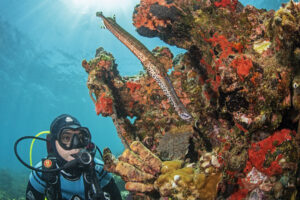
They’re also pioneering the concept of Marine Prosperity Areas—a framework that aligns ecological restoration with human well-being, demonstrating how conservation and economic prosperity can go hand in hand.
The global map, a massive and intricate effort, is now in its final stages before publication, but Atlas Aquatica is just getting started. So far, the initiative has helped form four diver cooperatives in Mexico, contributed to the protection of over six million hectares of marine territory, and monitored more than 100 dive sites.
Because when nature thrives, coastal economies follow. And few industries show that more clearly than diving.
“There are already dive sites generating revenue—we don’t need to convince anyone of that,” says Octavio. “What we need is to encourage people to organize. By doing so, they can strengthen both their local economies and the dive industry as a whole. If the dive sector gains the same recognition as other industries, then dive sites would be protected—not just for conservation, but to support and sustain the industry itself.”
DIVE DEEPER INTO COMMUNITY-LED OCEAN PROTECTION

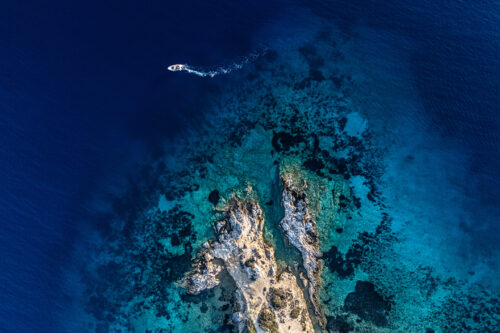
Amorgorama: A Fisher-Led Movement to Revive a Greek Island
